|
Decentralised Autonomous Organisation (DAO) Centralised Authoritarian Organisation (CAO): a potential example in action: I work in the Digital Media (DM) department at Central Saint Martins (CSM) a subsidiary of University of the Arts London (UAL) DM is itself a subsidiary of CSM Technical, a department. So, we can see this macro-organisation as a hierarchy/patriarchy hosting a community of micro-organisations: UAL/CSM/Technical/DM. This is the DAO (DM) nested in the CAO (UAL). This lop-sided ecology is increasingly weighted in financial favour and power as we move up the structure from multiple co-operatives e.g., DM to monopolistic corporate control. This is how it is now. The question then: Can institutional structures be made more equitable in as much as can the co-operative functionality at the bottom be migrated up the structure? I will attempt, at least to frame, the question more definitively after sketching out some sort of example of how this asymmetry currently manifests as far as I experience/perceive it from a low proletarian level within the organisation/machine. Universities generally function as feudal societies. They have a Chancellor, Vice Chancellor, Rector, Schools, Deans, Professors, Lecturers and Technicians for example. The also have departments dealing with functions such as finance and welfare as well as libraries and services like catering and building maintenance amongst others. These intersecting entities are typical of general and specific social organisational strucure. A ‘CAO’ Below is a typical example: A highly established vertical hierarchy that has become hyper-normalised, reinforced and consolidated over millennia. The CAO then as establishment monopole. However, my colleagues and myself within DM function on a day-to-day level much more like a DAO, cooperative, mutually referring and freely exchanging. I can give some examples of my own experience. A bit of context first: My designated role is as a specialist CAD technician though I have a history within CSM as a Research Fellow and as an Associate Lecturer. In this context my actual work practice, despite being labelled ‘Technical’, is considerably more than fifty percent researching artistic and technical potential as well as teaching animation at Master’s level. The ‘animation’ teaching is simultaneously technical, academic and aesthetic. This tripolar dynamic continues despite CSM bringing in consultants who advised the school to separate these three components into distinct practices in order to save money (just my little gripebut true nonetheless). Research: An example of collaborative team activity that I have participated in is an ongoing practical implementation of quick, affordable, home-made motion/performance capture research, construction and implementation. This has clear implications for developments relating to animation production and experimentation. So, in this context it has involved collaboration with animation staff and students as well as Fine Art, Performance, Fashion and people from other departments and of course colleagues within our own technical team who may be exploring and working similar systems. Motion capture suits and gloves being one example. There are also 3D scanning technologies that have potential to work in conjunction with performance capture. These collaborations have functioned in as much a peer-to-peer way to experiment with blended human/machine techniques as much if not more than as me being a teacher. Despite myself being the initiator once the process is under way very often all participants make significant contributions to process exploration. This group process has helped to gain funding from higher up the management chain of command; so there is both a hierarchical and decentralised set of processing at work in this example. Teaching: As far teaching goes I am responsible for teaching 3D Character animation to students primarily studying on the MA in Character Animation at CSM. This involves delivering lectures on the practical construction of animated characters as both a technical and artistic activity. The technical aspects involve CAD modelling of characters, rigging the characters and keying (animating) the characters. The artistic aspects involve creating a method based character backstory, identifying drives and emotional responses in this context and performing the character in accordance with a variety of animation principles. Within the character animation team there is a co-operative spirit within the boundaries of an established but flexible syllabus. We all have a range of experience in many different character animation styles, traditions and innovative approaches to animation. We also work collaborativley with staff and students from Performance, formally known as Drama Centre London, a leading acting school that used Method Acting, Stanislavsky and Laban Movement Analysis, methods CSM Performance continues to develop. Within the technical team there is a wide range of digital media skills. Virtual fashion, coding, game development Virtual and mixed reality to name a few. These intersecting departmental skills and technologies form a highly fertile hybrid environment. The relationship with the higher hierarchy structure that often remotely determines financial decisions can be frustratingly beaurocratic putting hurdles that become slow and arduous. Whilst we recognise that some sort of management decision making is neccessary in the current structural social/financial way things are organised Hence the question framed at the beginning: Can institutional structures be made more equitable in as much as can the co-operative functionality at the bottom be migrated up the structure? At this point I don't have a clear answer but the question remains pertinent and urgent within the current shifting context of accelerated change driven by financial, communicative and social technologies.
0 Comments
APOCALYPSEApocalypse; commonly taken to mean the end of the World and is generally considered in a religious context; the use of the term on this post derives from the Ancient Greek meaning: apokálypsis, (meaning "uncovering"), translated literally from Greek, is a disclosure of knowledge, i.e., a lifting of the veil or revelation. Images of storms are often associated with the popular idea of The Apocalypse. Storms on Earth are growing stronger as global warming progresses and flooding becomes more frequent. It could be that we are already experiencing the beginning of an apocalyptic historical period. We are clearly living in a time of simultaneously great threat and great promise. Accelerated and multi-directional change driven by explosive technological evolution. This "'Great Acceleration' was smashed into overdrive by the nuclear warfare unleashed on Japan in August 1945. 'Bear' is a NATO code name for the class of Russian bomber that dropped the most powerful bomb ever detonated in history. The Internet is a consequence of the nuclear age; the web was originally designed as a distributed network that could survive a nuclear war because it was organically spread across large regions of territory enabling parts of it to survive and function despite extensive damage. There are many technologies that have emerged since the industrial age and progressed into the digital age including the rapidly developing bio-tech revolution driven by the decoding of the genome. These technologies are beginning to combine living tissue and machines in increasingly intimate connectivity. The drawings in this post are about these biotech events that we are witnessing and participating in. These events include unintended consequences as well as deliberately constructed objectives. In 'Mobility' a human figure part flesh part machine is caught in a web of monstrous plumbing, nerves and wires bind her to a brain lobe in a tank connected to bigger streams and channels. We are now in a world that was conceived in some the most imaginative science fiction of the last century. Those of us who remember the Moon Landings will also recall the sense of terror produced by the Cold War when nuclear Armageddon seemed to be imminent. In fact it was this arms race that acted as a spur to the space race. As in most conflict much of this deferred warfare was about ideological and physical territory. Eastern Europe was the fulcrum of the disputed territories though the devastating effects of nuclear war threatened much greater areas. The stakes that were raised in this race for supremacy that risked destroying the physical territory were matched by the fiendish ingenuity that lay behind the technology of thermo-nuclear warfare. It was this sense of crisis that motivated the endeavour that put people on the Moon and all the technological innovation that was needed to do that. Satellites, computing, medical and terrain scanning are some examples of an explosion that produced the global connectivity that now seems normal and everyday. This binary condition of connection arising from conflict has always stimulated the way I have produced images. Genres from baroque chiaroscuro to modernist film noir inform my image making sometimes in form but more often in content and reflect my personal perception of the World. The chemistry arises from the way light emerges from darkness or to put it another way by illuminating darkness. Although my subjects are often dark I try to infuse them with humour. It's not so much that I relish catastrophe as I am excited by the opportunities for change that it brings. In 'Crash' a sports car lies crumpled in a forest and is beginning to be engulfed by vegetation. Its inertia futile in the face of slow but inevitable growth. In 'Fall and Rise' a ship drops behind into a trough between waves seemingly in peril but a movement in the sea draws a way forward toward the rising Sun. The big bang creation myth of the suggests that the imperfections, wrinkles and irregularities of the expanding surface gave rise to the contrasts that enabled structures like galaxies to form; is it possible that these 'imperfections' cascade up in the complexity hierarchy of material structures from subatomic events through chemical and biological processes to drive the complex cultural contradictions that we experience as crises? |
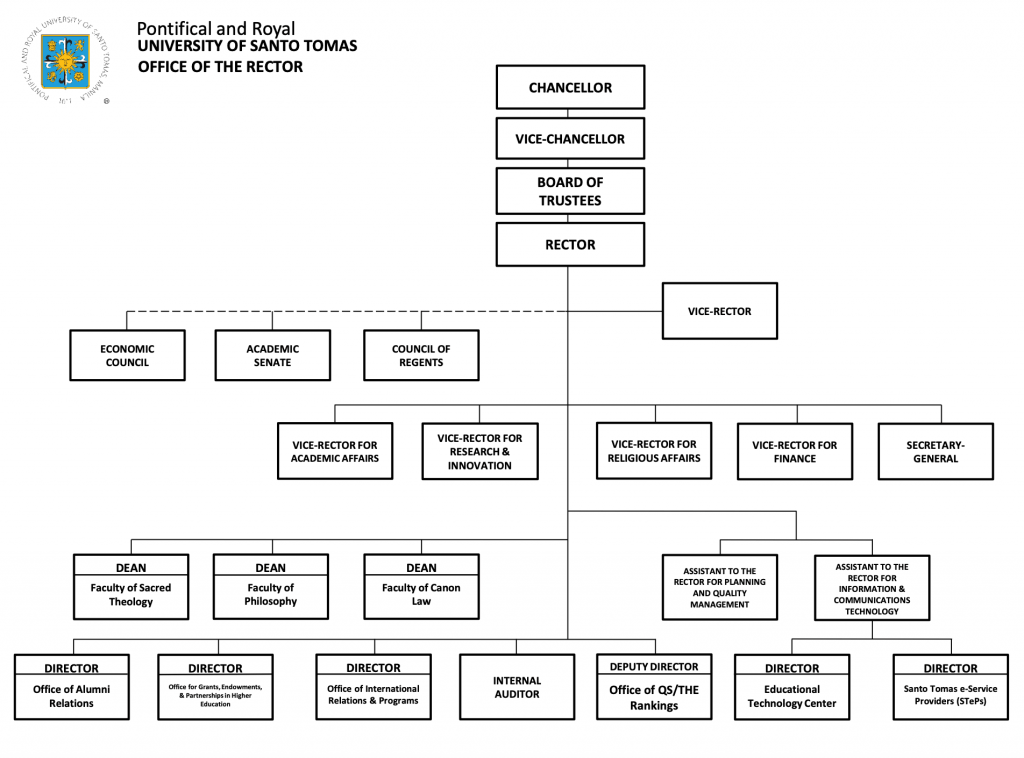
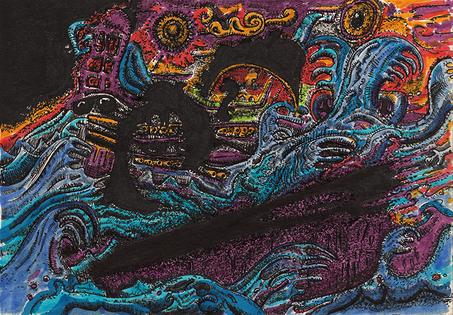
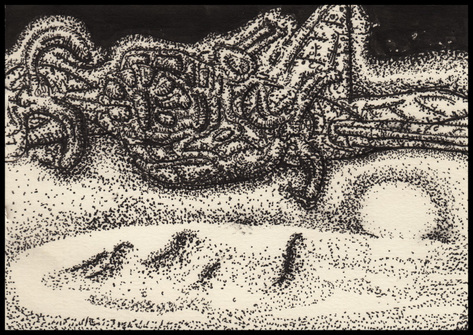
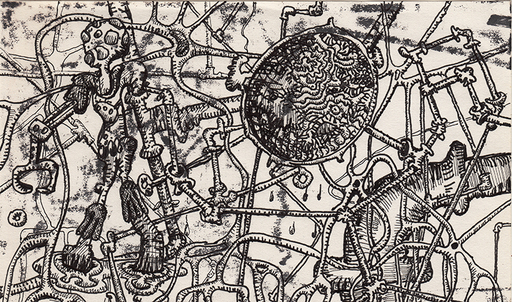
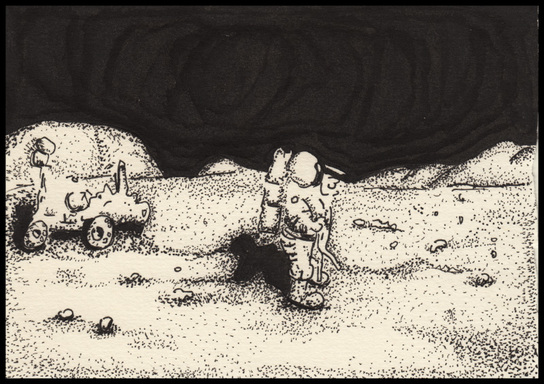
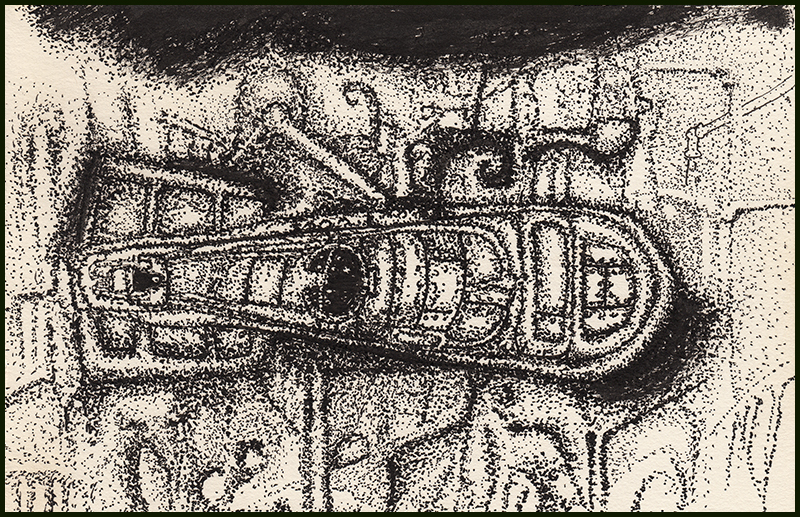


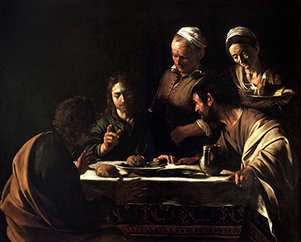

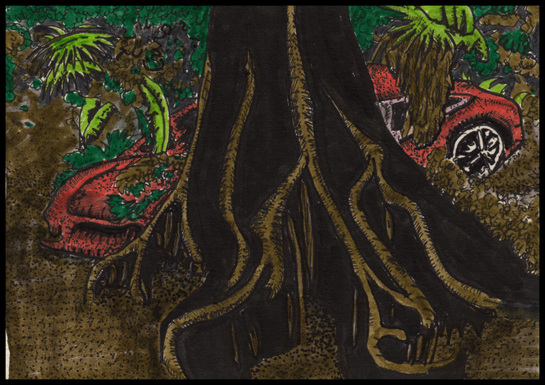
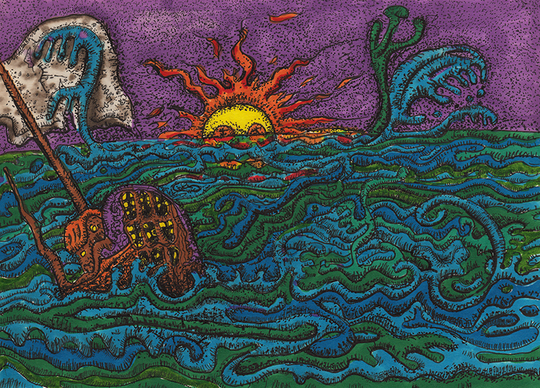
 RSS Feed
RSS Feed